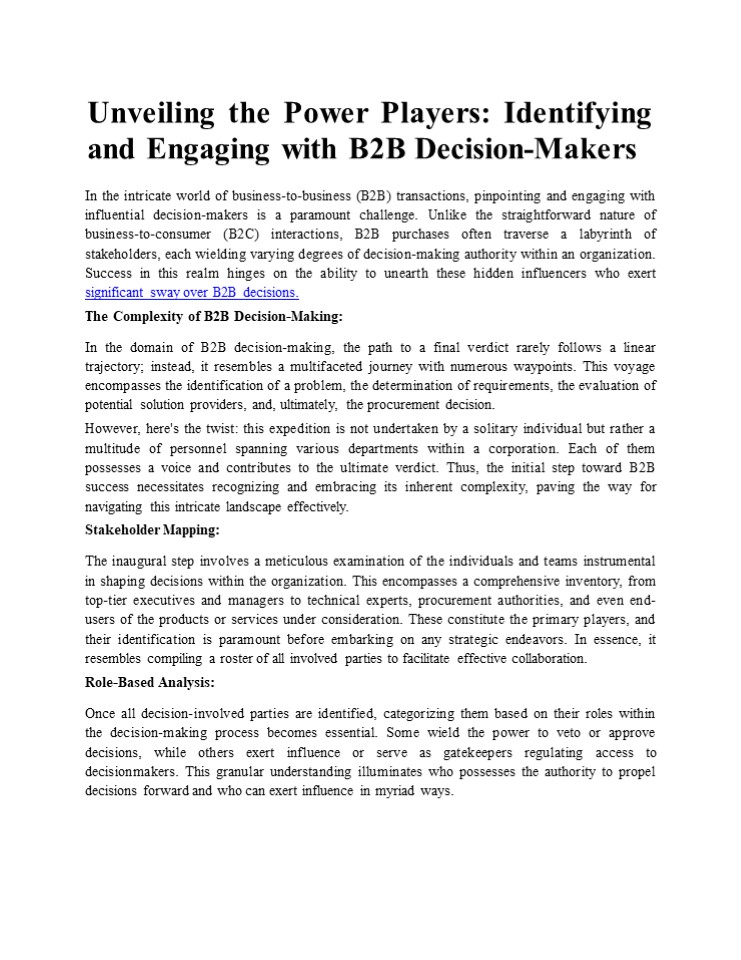B2B Decision-Makers - PowerPoint PPT Presentation
Title:
B2B Decision-Makers
Description:
B2B Decision-Makers – PowerPoint PPT presentation
Number of Views:0
Title: B2B Decision-Makers
1
Unveiling the Power Players Identifying and
Engaging with B2B Decision-Makers
In the intricate world of business-to-business
(B2B) transactions, pinpointing and engaging with
influential decision-makers is a paramount
challenge. Unlike the straightforward nature of
business-to-consumer (B2C) interactions, B2B
purchases often traverse a labyrinth of
stakeholders, each wielding varying degrees of
decision-making authority within an organization.
Success in this realm hinges on the ability to
unearth these hidden influencers who exert
significant sway over B2B decisions. The
Complexity of B2B Decision-Making In the domain
of B2B decision-making, the path to a final
verdict rarely follows a linear trajectory
instead, it resembles a multifaceted journey with
numerous waypoints. This voyage encompasses the
identification of a problem, the determination of
requirements, the evaluation of potential
solution providers, and, ultimately, the
procurement decision. However, here's the twist
this expedition is not undertaken by a solitary
individual but rather a multitude of personnel
spanning various departments within a
corporation. Each of them possesses a voice and
contributes to the ultimate verdict. Thus, the
initial step toward B2B success necessitates
recognizing and embracing its inherent
complexity, paving the way for navigating this
intricate landscape effectively. Stakeholder
Mapping The inaugural step involves a meticulous
examination of the individuals and teams
instrumental in shaping decisions within the
organization. This encompasses a comprehensive
inventory, from top-tier executives and managers
to technical experts, procurement authorities,
and even end-users of the products or services
under consideration. These constitute the primary
players, and their identification is paramount
before embarking on any strategic endeavors. In
essence, it resembles compiling a roster of all
involved parties to facilitate effective
collaboration. Role-Based Analysis Once all
decision-involved parties are identified,
categorizing them based on their roles within the
decision-making process becomes essential. Some
wield the power to veto or approve decisions,
while others exert influence or serve as
gatekeepers regulating access to decisionmakers.
This granular understanding illuminates who
possesses the authority to propel decisions
forward and who can exert influence in myriad
ways.
2
Network Analysis
Within many organizations, individuals hold
significant influence without formally occupying
leadership positions. These influential figures
often operate discreetly behind the scenes.
Employing network analysis tools and techniques
allows for the discovery of these informal
connections and networks within the organization.
Even if they lack an official decision-making
role, this approach unveils the key players,
their communication dynamics, and the extent of
their impact. Digital Footprint In today's
digital era, prominent decision-makers often
leave a digital trail of their online activities.
Platforms like LinkedIn, industry-specific
forums, and social media provide opportunities to
identify individuals actively engaged in
discussions relevant to your business or product
category. This strategy enables the discovery and
engagement of professionals genuinely interested
in what your offerings bring to the
table. Surveys and Interviews Gaining deeper
insights into decision-making processes within
specific industries or organizations can be
achieved through surveys or interviews with
individuals employed within those entities or
possessing insider knowledge. This entails direct
communication with customers or industry experts
to glean insights into the rationale and
mechanisms driving decision-making. In simpler
terms, it's akin to conversing with individuals
who either make purchases from a company or
possess profound knowledge of industry dynamics,
shedding light on how and why decisions unfold in
those contexts. Engaging with Hidden
Influencers Content Personalization Recognize
that each participant in a project or
decision-making process harbors unique concerns
and priorities. Addressing these specific needs
requires tailoring the information and messaging
you disseminate. What resonates with a technical
specialist may not hold significance for someone
responsible for procurement decisions. Thought
Leadership Establishing your brand as a
respected authority in your sector necessitates
sharing relevant expertise and knowledge.
Influential figures who often operate in the
shadows closely follow industry experts and
actively seek out those with authoritative voices.
3
Relationship Building
Forge alliances with influential figures in your
industry. Participate in events, online seminars,
and gatherings where you can establish in-person
connections. In B2B, trust and robust
relationships hold immense value. Educational
Initiatives Offer educational resources such as
webinars, whitepapers, and case studies
addressing specific organizational pain points or
challenges. Demonstrating your competence and
commitment to problem-solving can win over
influencers. Clear Value Proposition Make it
unequivocally clear why your product or service
is indispensable to the organization. Even those
who wield influence behind the scenes should
grasp how your offerings align with the company's
objectives. Leverage Advocacy Encourage
satisfied clients and industry partners to
advocate for your company. Their endorsements
carry weight and can reach crucial
decision-makers more effectively than traditional
advertising. In conclusion, the task of
identifying and engaging with hidden influencers
in B2B decisionmaking may appear daunting.
However, by comprehensively mapping all involved
individuals, delineating their roles, analyzing
their connections, and adapting your approach to
each, businesses can enhance their prospects of
securing B2B deals and cultivating enduring
relationships. In the realm of B2B, where
decisions often transpire discreetly, the ability
to identify and influence key decision-makers can
be pivotal to success.































